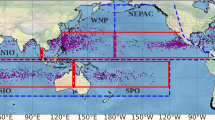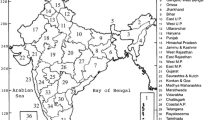Abstract
The paper uses observational data from 1950 to 2014 to investigate rapid intensification (RI) variability of tropical cyclones (TCs) in the North Atlantic and its relationships with large-scale climate variations. RI is defined as a TC intensity increase of at least 15.4 m/s (30 knots) in 24 h. The seasonal RI distribution follows the seasonal TC distribution, with the highest number in September. Although an RI event can occur anywhere over the tropical North Atlantic (TNA), there are three regions of maximum RI occurrence: (1) the western TNA of 12°N–18°N and 60°W–45°W, (2) the Gulf of Mexico and the western Caribbean Sea, and (3) the open ocean southeast and east of Florida. RI events also show a minimum value in the eastern Caribbean Sea north of South America—a place called a hurricane graveyard due to atmospheric divergence and subsidence. On longer time scales, RI displays both interannual and multidecadal variability, but RI does not show a long-term trend due to global warming. The top three climate indices showing high correlations with RI are the June-November ENSO and Atlantic warm pool indices, and the January-March North Atlantic oscillation index. It is found that variabilities of vertical wind shear and TC heat potential are important for TC RI in the hurricane main development region, whereas relative humidity at 500 hPa is the main factor responsible for TC RI in the eastern TNA. However, the large-scale oceanic and atmospheric variables analyzed in this study do not show an important role in TC RI in the Gulf of Mexico and the open ocean southeast and east of Florida. This suggests that other factors such as small-scale changes of oceanic and atmospheric variables or TC internal processes may be responsible for TC RI in these two regions. Additionally, the analyses indicate that large-scale atmospheric and oceanic variables are not critical to TC genesis and formation; however, once a tropical depression forms, large-scale climate variations play a role in TC intensification.















Similar content being viewed by others
References
Balaguru K et al (2012) Ocean barrier layers’ effect on tropical cyclone intensification. Proc Natl Acad Sci 109(36):14343–14347
Bender MA, Ginis I (2000) Real-case simulations of hurricane–ocean interaction using a high resolution coupled model: effects on hurricane intensity. Mon Weather Rev 128:917–946
Camargo SJ, Wheeler MC, Sobel AH (2009) Diagnosis of the MJO modulation of tropical cyclogenesis using an empirical index. J Atmos Sci 66:3061–3074
Carton JA, Giese BS (2008) A reanalysis of ocean climate using simple ocean data assimilation (SODA). Mon Weather Rev 136:2999–3017
Chen H, Zhang DL, Carton J, Atlas R (2011) On the rapid intensification of Hurricane Wilma (2005). Part I: Model prediction and structural changes. Weather Forecast 26:885–901
Compo GP et al (2011) The twentieth century reanalysis project. Q J R Meteorol Soc 137:1–28
Delworth TL, Mann ME (2000) Observed and simulated multidecadal variability in the Northern Hemisphere. Clim Dyn 16:661–676
Elsberry RL (2014) Advances in research and forecasting of tropical cyclones from 1963 to 2013. Asia-Pac J Atmos 50:3–16
Elsberry R, Lambert TDB, Boothe MA (2007) Accuracy of Atlantic and eastern North Pacific tropical cyclone intensity forecast guidance. Weather Forecast 22:747–762
Emanuel K, Nolan DS (2004) Tropical cyclone activity and the global climate system. Proc 26 AMS Conf Hurr Trop Meteor 10:240–241
Emanuel KA, DesAutels C, Holloway C, Korty R (2004) Environmental control of tropical cyclone intensity. J Atmos Sci 61:843–858
Enfield DB, Mestas-Nuñez AM, Trimble PJ (2001) The Atlantic multidecadal oscillation and its relation to rainfall and river flows in the continental US. Geophys Res Lett 28:2077–2080
Enfield DB, Lee SK, Wang C (2006) How are large Western Hemisphere Warm Pools formed? Prog Oceanogr 70(2–4):346–365
Goldenberg SB, Shapiro LJ (1996) Physical mechanisms for the association of El Nino and West African rainfall with Atlantic major hurricanes. J Climate 9:1169–1187
Goldenberg SB, Landsea C, Mestas-Nunez AM, Gray WM (2001) The recent increase in Atlantic hurricane activity. Science 293:474–479
Gray WM (1979) Hurricanes: their formation, structure and likely role in the tropical circulation. In: Shaw DB (ed) Meteorology over the tropical oceans. Royal Meteorological Society, Bracknell, pp 155–218
Gray WM (1984) Atlantic seasonal hurricane frequency. Part I: El Nino and 30-mb quasi-biennial oscillation influences. Mon Weather Rev 112:1649–1668
Gray WM (1988) Environmental influences on tropical cyclones. Aust Meteor Mag 36:127–139.
Hendricks EA, Peng MS, Fu B, Li T (2010) Quantifying environmental control on tropical cyclone intensity change. Mon Weather Rev 138:3243–3271
Hong X et al (2000) The Interaction between Hurricane Opal (1995) and a Warm Core Ring in the Gulf of Mexico. Mon Weather Rev 128:1347–1365
Hurrel JM (1996) Influence of variations in extratropical wintertime teleconnections on Northern Hemisphere temperature. Geophys Res Lett 23:665–668
Jiang X, Zhao M, Waliser DE (2012) Modulation of tropical cyclone activity by the tropical intraseasonal oscillation over the Eastern Pacific in a high resolution GCM. J Clim 25:6524–6538
Kalnay E et al (1996) The NCEP/NCAR 40-year reanalysis project. Bull Am Meteorol Soc 77:437–471
Kaplan J, DeMaria M (2003) Large-scale characteristics of rapidly intensifying tropical cyclones in the North Atlantic basin. Weather Forecast 18:1093–1108
Kaplan J, DeMaria M, Knaff JA (2010) A revised tropical cyclone rapid intensification index for the Atlantic and East Pacific basins. Weather Forecast 25:220–241
Kaplan J et al (2015) Evaluating environmental impacts on tropical cyclone rapid intensification predictability utilizing statistical models. Weather Forecast 30:1374–1396
Klotzbach PJ (2012) El Nino-Southern Oscillation, the Madden-Julian Oscillation and Atlantic basin tropical cyclone rapid intensification. J Geophys Res 117:D14104. doi:10.1029/2012JD017714
Klotzbach PJ, Landsea CW (2015) Extremely intense hurricanes: Revisiting Webster et al. (2005) after 10 years. J Clim 28:7621–7629
Landsea CW, Vecchi GA, Bengtsson L, Knutson TR (2010) Impact of duration thresholds on Atlantic tropical cyclone counts. J Clim 23:2508–2519
Lee CY, Tippett MK, Sobel AH, Camargo SJ (2016) Rapid intensification and the bimodal distribution of tropical cyclone intensity. Nat Commun. doi:10.1038/ncomms10625
Leipper D (1967) Observed ocean conditions and Hurricane Hilda, 1964. J Atmos Sci 24:182–196
Leipper D, Volgenau D (1972) Hurricane heat potential of the Gulf of Mexico. J Phys Oceanogr 2:218–224
Lin II, Wu CC, Emanuel K, Lee IH, Wu CR, Pun IF (2005) The interaction of Supertyphoon Maemi (2003) with a warm ocean eddy. Mon Weather Rev 133(9):2635–2649
Lin II, Wu CC, Pun IF, Ko DS (2008) Upper-ocean thermal structure and the western North Pacific category 5 typhoons. Part I: ocean features and the category 5 typhoons’ intensification. Mon Weather Rev 136(9):3288–3306
Lin II, Chen CH, Pun IF, Liu WT, Wu CC (2009a) Warm ocean anomaly, air sea fluxes, and the rapid intensification of tropical cyclone Nargis (2008). Geophys Res Lett 36:L03817
Lin II, Pun IF, Wu CC (2009b) Upper ocean thermal structure and the western North Pacific category-5 typhoons part II: dependence on translation speed. Mon Weather Rev 137(11):3744–3757
Medhaug I, Furevik T (2011) North Atlantic 20th century multidecadal variability in coupled climate models: sea surface temperature and ocean overturning circulation. Ocean Sci 7:389–404
Merrill RT (1988) Environmental influences on hurricane intensification. J Atmos Sci 45:1678–1687
Quenouille MH (1952) Associated measurements. Butterworths Scientific, London, p 242
Rappaport EN et al (2009) Advances and challenges at the National Hurricane Center. Weather Forecast 24:395–419
Shay LK, Goni GJ, Black PG (2000) Effects of a warm oceanic feature on Hurricane. Opal. Mon Weather Rev 128:1366–1383
Shieh OH, Colucci SJ (2010) Local minimum of tropical cyclogenesis in the eastern Caribbean. Bull Am Meteor Soc 91:185–196
Shu SJ, Ming J, Chi P (2012) Large-scale characteristics and probability of rapidly intensifying tropical cyclones in the western north pacific basin. Weather Forecast 27:411–423
Smith TM, Reynolds RW, Peterson TC, Lawrimore J (2008) Improvements to NOAA's historical merged land–ocean surface temperature analysis (1880–2006). J Clim 21:2283–2296
Sutyrin GG, Khain AP (1984) Effect of the ocean–atmosphere interaction on the intensity of a moving tropical cyclone. Atmos Ocean Phys 20:697–703
Vecchi GA, Knutson TR (2008) On estimates of historical North Atlantic tropical cyclone activity. J Clim 21:3580–3600
Vecchi GA, Soden BJ (2007) Increased tropical Atlantic wind shear in model projections of global warming. Geophys Res Lett 34:L08702. doi:10.1029/2006GL028905
Vimont DJ, Battisti DS, Hirst AC (2001) Footprinting: a seasonal connection between the tropics and mid-latitudes. Geophys Res Lett 28:3923–3926
Vimont DJ, Battisti DS, Hirst AC (2003) The seasonal footprinting mechanism in the CSIRO general circulation models. J Clim 16:2653–2667
Wang C (2007) Variability of the Caribbean low-level jet and its relations to climate. Clim Dyn 29:411–422
Wang C, Enfield DB (2001) The tropical western hemisphere warm pool. Geophys Res Lett 28:1635–1638
Wang C, Enfield DB (2003) A further study of the tropical Western Hemisphere warm pool. J Clim 16:1476–1493
Wang C, Enfield DB, Lee SK, Landsea CW (2006) Influences of the Atlantic warm pool on Western Hemisphere summer rainfall and Atlantic hurricanes. J Clim 19:3011–3028
Wang C, Lee SK, Enfield DB (2008) Atlantic warm pool acting as a link between Atlantic multidecadal oscillation and Atlantic tropical cyclone activity. Geochem Geophys Geosyst 9:Q05V03. doi:10.1029/2007GC001809.
Wang C, Dong S, Evan AT, Foltz GR, Lee SK (2012) Multidecadal covariability of North Atlantic sea surface temperature, African dust, Sahel rainfall and Atlantic hurricanes. J Clim 25:5404–5415
Xie SP (1999) A dynamic ocean-atmosphere model of the tropical Atlantic decadal variability. J Clim 12:64–70
Xie SP, Philander SGH (1994) A coupled ocean–atmosphere model of relevance to the ITCZ in the eastern Pacific. Tellus 46A:340–350
Zhang L, Wang C (2012) Remote influences on freshwater flux variability in the Atlantic warm pool region. Geophys Res Lett 39:L19714. doi:10.1029/2012GL053530
Acknowledgements
We thank three reviewers for providing useful comments and suggestions that helped us improve the manuscript. This work was supported by grants from the National Basic Research Program of China (2013CB430301 and 2013CB430304), National Natural Science Foundation (41376015), the National Program on Global Change and Air-Sea Interaction (GASI-IPOVAI-04), and the Pioneer Hundred Talents Program of the Chinese Academy of Sciences. The findings and conclusions in this report are those of the author(s) and do not necessarily represent the views of the funding agency.
Author information
Authors and Affiliations
Corresponding authors
Rights and permissions
About this article
Cite this article
Wang, C., Wang, X., Weisberg, R.H. et al. Variability of tropical cyclone rapid intensification in the North Atlantic and its relationship with climate variations. Clim Dyn 49, 3627–3645 (2017). https://doi.org/10.1007/s00382-017-3537-9
Received:
Accepted:
Published:
Issue Date:
DOI: https://doi.org/10.1007/s00382-017-3537-9




